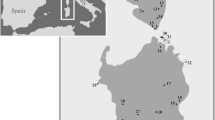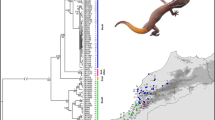Abstract
California is a biodiversity hotspot facing unbridled human population growth, especially in Central California. One of the poorly known, sensitive species in this area is the California legless lizard (Anniella pulchra), a fossorial worm-like reptile. We report mt and nuDNA sequences from 69 museum-vouchered samples of Anniella (A. pulchra and its sister species A. geronimensis) from 48 localities. Our genetic survey reveals substantially more genetic diversity within A. pulchra than previously reported. Our two independently evolving markers (mt and nuDNA) reveal five major lineages of A. pulchra. Two of the five major lineages of A. pulchra correspond to a north-south split found in other widespread California reptiles. These northern and southern clades also correspond to a previous study showing variation in chromosomal number. Unlike most other Californian reptiles, A. pulchra has major genetic lineages that are endemic to Central California including two that are endemic to the San Joaquin Valley and Carrizo Plain. Although A. pulchra is threatened throughout its range, the distinct San Joaquin lineages are seriously imperiled by urban sprawl. Some of the localities for the newly recognized genetic lineages have already been destroyed by development.



Similar content being viewed by others
References
Ast JC (2001) Mitochondrial DNA evidence and evolution in Varanoidea (Squamata). Cladistics 17:211–226
Bezy RL, Gorman GC, Kim YK, Wright JW (1977) Chromosomal and genetic divergence in the fossorial lizards of the family Anniellidae. Syst Zool 26:57–71
Bezy RL, Wright JW (1971) Karyotopic variation and relationships of the California legless lizard, Anniella pulchra Gray (Reptilia: Anniellidae). Herpetol Rev 3:71–72
Clement M, Posada D, Crandall KA (2000) TCS: a computer program to estimate gene genealogies. Mol Ecol 9:1657–1659
Feldman CR, Spicer GS (2006) Comparative phylogeography of woodland reptiles in California: repeated patterns of cladogenesis and population expansion. Mol Ecol 15:2201–2222
Felsenstein J (1985) Confidence limits on phylogenies: an approach using the bootstrap. Evolution 39:783–791
Fischer JG (1885) Uber eine zweite Art der Gattung Anniella Gray. Abhandl Naturwiss Verein Hamburg 9:9–10
Gray JE (1852) Descriptions of several new genera of reptiles, principally from the collection of the H.M.S. Herald. Ann Mag Nat Hist Ser 2 10:437–440
Great Valley Center (2007) Our valley. Our choice. Great Valley Center, Modesto
Hall CA (2002) Nearshore marine paleoclimatic regions, increasing zoogeographic provinciality, mollsucan extinctions, and paleoshorelines, California: Late Oligocene (27 Ma) to Late Pliocene (2.5 Ma). Geol Soc Am Spec Pap 357
Hunt LE (1983) A nomenclatural rearrangement of the genus Anniella (Sauria: Anniellidae). Copeia 1983:79–89
Hunt LE (1984) Morphological variation in the fossorial lizard Anniella. Master’s Thesis, University of Kansas
Jockusch EL, Wake DB (2002) Falling apart and merging: diversification of slender salamanders (Plethodontidae: Batrachoseps) in the American West. Biol J Linn Soc 76:361–391
Jockusch EL, Wake DB, Yanev KP (1998) New species of slender salamanders, Batrachoseps (Amphibia: Plethodontidae), from the Sierra Nevada of California. Nat Hist Mus Los Angeles Co Sci Ser 472:1–17
Kolankiewicz L, Beck R (2000) Sprawl in California. NumbersUSA, Arlington
Leache AD, Mulcahy DM (2007) Phylogeny, divergence times and species limits of spiny lizards (Sceloporus magister species group) in western North American deserts and Baja California. Molec Ecol 16:5216–5233
Macey JR, Schulte JA, Larson A, Tuniyev BS, Orlov N, Papenfuss TJ (1999) Molecular phylogenetics, tRNA evolution, and historical biogeography in anguid lizards and related taxonomic families. Mol Phylogenet Evol 12:250–272
Myers N, Mittermeier RA, Mittermeier CG, da Fonseca GAB, Kent J (2000) Biodiversity hotspots for conservation priorities. Nature 403:853–858
Noonan BP, Chippendale PT (2006) Dispersal and vicariance: the complex evolutionary history of boid snakes. Mol Phylogenet Evol 40:347–358
Papenfuss TJ, Macey JR, Schulte JA (2001) A new lizard species in the genus Xantusia. Pap Nat Hist Mus Univ Kansas 23:1–9
Parham JF, Irmis RB (2008) Caveats on the use of fossil calibrations for molecular dating. Am Nat 171:132–136
Parham JF, Macey JR, Papenfuss TJ, Feldman CR, Türkozan O, Polymeni R, Boore JL (2006) The phylogeny of Mediterranean tortoises and their close relatives based on complete mitochondrial genome sequences from museum specimens. Mol Phylogenet Evol 38:50–64
Pearse DE, Pogson GH (2000) Parallel evolution of the melanic form of the California legless lizard, Anniella pulchra, inferred from mitochondrial sequence variation. Evolution 54:1041–1046
Posada D, Crandall KA (1998) Modletest: testing the model of DNA substitution. Bioinformatics 14:817–818
PPIC (2006) CA2025—California’s future population. Public Policy Institute of California, Sacramento
Rissler LJ, Hijmans RJ, Graham CH, Moritz C, Wake DB (2006) Phylogeographic lineages and species comparisons in conservation analyses: A case study of California Herpetofauna. Am Nat 167:655–666
Shaw CE (1940) A new species of legless lizard from San Geronimo Island, Lower California, Mexico. Trans San Diego Soc Nat Hist 9:225–228
Spinks PQ, Shaffer HB (2005) Range-wide molecular analysis of the western pond turtle (Emys marmorata): cryptic variation, isolation by distance, and their conservation implications. Mol Ecol 14:2047–2064
Stamatakis A (2006a) Phylogenetic models of rate heterogeneity: a high performance computing perspective. Parallel and Distributed Processing Symposium, 2006. doi:10.1109/IPDPS.2006.1639535
Stamatakis A (2006b) RAxML-VI-HPC: maximum likelihood based phylogenetic analyses with thousands of taxa and mixed models. Bioinformatics 22:2688–2690
Swofford DL (2002) PAUP*: Phylogenetic analysis using parsimony *(and other methods), version 4.0b10. Sinauer Associates, Sunderland
Wake DB (2006) Problems with species: patterns and processes of species formation in salamanders. Ann Mo Bot Gard 93:8–23
Acknowledgments
Many people helped with this project, but two individuals deserve special thanks: (1) David Germano (California State, Bakersfield) discovered the first populations of lineages B and C and brought them to our attention; (2) Chris Feldman (Utah State University) is thanked for fieldwork, discussions, figure help, and major assistance with the analyses. Brian Simison (CAS) greatly facilitated molecular labwork at the Osher Molecular Laboratory. Carol Spencer is thanked for her help with the timely accession of MVZ specimens. Jens Vindum and Hallie Bringnall are thanked for information about specimens at CAS. Gabriel Parra-Olea (IBH) provided data and tissues for a specimen at that museum. Fieldwork was either directly performed or facilitated by Kathy Sharum (Carrizo Plains National Monument), Greg Warrick (Sand Ridge), Sarah Rieboldt (University of California Museum of Paleontology), Jonathan Richmond (University of Connecticut, Cornell University), Greg Pauly (University of Texas), Gabriela Parra-Olea, Barbara Bradford (Riverbank), Dave Clendenden (Wind Wolves Preserve), Dan Rosenberg (Oregon State), and Vince Franke (Pergerine Productions). Jonathan Fong (Museum of Vertebrate Zoology) and Bryan Stuart (Field Museum of Natural History) are thanked for help with the phylogenetic analyses. Dan Mulcahy (Brigham Young University), Lawrence E. Hunt (Santa Barbara Natural History Museum), and Paul Collins (Santa Barbara Natural History Museum) provided insightful discussions on this research. Eliana Parham (Pensacola, FL) and Sarah Rieboldt provided other invaluable assistance. This is UCMP contribution # 1962.
Author information
Authors and Affiliations
Corresponding author
Appendix
Appendix
The following is a list of the voucher information (see text for institutional abbreviations) followed by the Genbank numbers for 70 samples (five outgroups [one E. coerulea, four A. geronimensis] and 65 A. pulchra). Genbank numbers are listed as mu/mtDNA although for samples sequenced by other authors the sole GenBank number refers to mtDNA.
A. pulchra: (1) MVZ 247492, EU445844/EU445910; (2) MVZ-228815, AF085606 (Macey et al. 1999); (3) MVZ 230659, EU445845/EU445911; 4) MVZ 232692, EU445846/EU445912; (5) MVZ 247489, EU445847/EU445913; (6) MVZ 247486, EU445848/EU445914; (7) MVZ 230718, EU445849/EU445915; (8) MVZ 247490, EU445850/EU445916; (9) MVZ 250572, EU445851/EU445917; (10) MVZ 257746, EU445852/EU445918; (11) CAS 20294, AF407537 (Ast 2001); (12) MVZ 191026, EU445853/EU445919; (13) MVZ 147932, EU445854/EU445920; (14) MVZ 232852, EU445855/EU445921; (15) MVZ 228845, EU445856/EU445922; (16) MVZ 257098, EU445857/EU445923; (17) MVZ 257731, EU445858/EU445924; (18a) TNCH 65020, EU445859/EU445925; (18b) TNCH 65021, EU445860/EU445926; (19) MVZ 250536, EU445862/EU445927; (20) MVZ 230660, EU445863/EU445929; (21) MVZ 250551, EU445861/EU445928; (22a) MVZ 257740, EU445864/EU445930; (22b) MVZ 257739, EU445865/EU445931; (23a) MVZ 257717, EU445866/EU445932; (23b) MVZ 250549, EU445867/EU445933; (23c) MVZ 250550, EU445868/EU445934; (23d) MVZ 257718, EU445869/EU445935; (23e) CAS 238588, EU445870/EU445936; (24a) MVZ 250541, EU445871/EU445937; (24b) MVZ 247487, EU445872/EU445938; (24c) MVZ 257726, EU445873/EU445939; (24d) MVZ 257725, EU445874/EU445940; (24e) MVZ 250546, EU445875/EU445941; (24f) MVZ 257742, EU445876/EU445942; (25a) MVZ 257714, EU445877/EU445943; (25b) MVZ 257715, EU445878/EU445944; (25c) MVZ 257716, EU445879/EU445945; (26) MVZ 230665, EU445880/EU445946; (27a) MVZ 257737, EU445881/EU445947; (27b) MVZ 257738, EU445882/EU445948; (28) MVZ 232844, EU445883/EU445949; (29a) MVZ 228817, EU445884/EU445950; (29b) MVZ 257727, EU445885/EU445951; (29c) MVZ 257728, EU445886/EU445952; (30) MVZ 250552, EU445887/EU445953; (31) MVZ 250555, EU445888/EU445954; (32) MVZ 250556, EU445889/EU445955; (33) MVZ 250559, EU445890/EU445956; (34) MVZ 230673, EU445891/EU445957; (35) MVZ 237407, EU445892/EU445958; (36) MVZ 237402, EU445893/EU445959; (37) MVZ 230674, EU445894/EU445960; (38) MVZ 230671, EU445895/EU445961; (39) MVZ 230666, EU445896/EU445962; (40) MVZ 250533, EU445897/EU445963; (41a) MVZ 237399, EU445898/EU445964; (42a) MVZ 250530, EU445899/EU445965; (42b) MVZ 250532, EU445900/EU445966; (43) CAS 236208, EU445901/EU445967; (44a) MVZ 257735, EU445902/EU445968; (44b) MVZ 257736, EU445903/EU445969; (45a) MVZ 257721, EU445904/EU445970; (45b) MVZ 257722, EU445905/EU445971; (45c) MVZ 257723, EU445906/EU445972. A. geronimensis: 41b) MVZ134196, AF085605 (Macey et al. 1999); (46) IBH 14314, EU445907/EU445973; (47) MVZ 237393, EU445908/EU445974; (48) MVZ 237396, EU445909/EU445975. E. coerulea: MVZ 228806, AF085617 (Macey et al. 1999).
Rights and permissions
About this article
Cite this article
Parham, J.F., Papenfuss, T.J. High genetic diversity among fossorial lizard populations (Anniella pulchra) in a rapidly developing landscape (Central California). Conserv Genet 10, 169–176 (2009). https://doi.org/10.1007/s10592-008-9544-y
Received:
Accepted:
Published:
Issue Date:
DOI: https://doi.org/10.1007/s10592-008-9544-y




